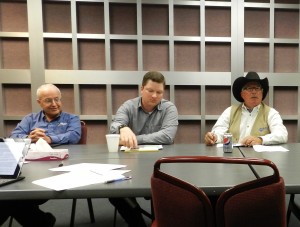
“We’re in a new world here,” said John Mensinger during last Tuesday’s Water Workshop in the Modesto Irrigation District’s (MID) boardroom. And while many in the audience seemed to agree, his fellow directors apparently weren’t listening.
The subject was a modest proposal by MID staff to increase water rates to $29.25 an acre foot by 2017. People in the know about today’s water world might think $29.25 is a misprint, and they’d have every reason to believe so.
In Westlands Water District, those who could get irrigation water paid between $800 and $1100 an acre foot last year. The city of San Francisco currently pays around $1300 an acre foot and is expecting a substantial increase in the next couple of years. Down south, the city of San Diego recently negotiated with a desalination plant for water at $2000 an acre foot.
Abundant water has always been the rule in and around Stanislaus County. Even the recent drought hasn’t brought a halt to an unprecedented increased in irrigated acreage as the almond boom fosters a burgeoning forest almost daily.
Given the increased demand, it would seem to follow the price of water would rise. And it has risen— everywhere but locally. Despite compelling reasons, MID Directors seem unwilling to deal with today’s water realities. At Tuesday’s meeting, only Mensinger supported staff proposals for modest rate increases.
Consider this: Current rates don’t begin to pay for the cost of delivering MID irrigation water. In part due to stories in the Modesto Bee, MID electric customers believe they are subsidizing local farmers to the tunes of millions of dollars. MID Directors say this isn’t so, but are unable to offer hard data in support of their claims.
At Tuesday’s meeting, Director Larry Byrd said that MID workers were struggling with outdated equipment and reduced manpower:
“Our water department is down to the bare bones,” he said. “We don’t have the revenues.”
But then he went on to say that public concern about low water rates was unjustified and the result of the complaints of “three or four individuals.”
Fellow board member Jake Wenger pointed out that electric rates had gone up because of “bad management” during the past administration. Wenger’s partially correct, but that’s a separate issue altogether from irrigation rates. It also doesn’t address Byrd’s point about a “bare bones” water department.
Director Paul Campbell seemed content to blame upcoming state requirements for increases in unimpaired flows for any and all problems faced by the district. Campbell’s rant has become the default position of anyone unwilling to face the realities of a new water world, where population growth, climate change, and an unprecedented shift in agriculture to permanent crops have stressed resources beyond sustainability.
When local leaders complain about the state’s “water grab” and bemoan the loss of some of their water rights, they ignore current realities. When over 80 percent of Tuolumne River water is diverted away from Delta farmers and fisheries, and when local water prices are in the lower two digits, it’s not unreasonable to conclude local water users have been making too much of a good thing.
“I think it’s reasonable to listen to staff,” said John Mensinger last Tuesday.
He might have added that railing against the state and clinging to water policies of the distant past won’t win much support from a public that has become disenchanted with the status quo. MID Directors still have a chance to listen and learn from last week’s Water Workshop. Let’s hope they’re willing.
